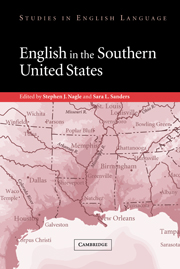Book contents
- Frontmatter
- Contents
- Notes on the contributors
- Acknowledgments
- Introduction
- 1 The origins of Southern American English
- 2 Shakespeare in the coves and hollows? Toward a history of Southern English
- 3 Eight grammatical features of southern United States speech present in early modern London prison narratives
- 4 The shared ancestry of African-American and American-White Southern Englishes: some speculations dictated by history
- 5 The complex grammatical history of African-American and white vernaculars in the South
- 6 Grammatical features of southern speech: yall, might could, and fixin to
- 7 Sounding southern: a look at the phonology of English in the South
- 8 Vowel shifting in the southern states
- 9 Enclave dialect communities in the South
- 10 Urbanization and the evolution of Southern American English
- 11 The Englishes of southern Louisiana
- 12 Features and uses of southern style
- References
- Index
10 - Urbanization and the evolution of Southern American English
Published online by Cambridge University Press: 22 September 2009
- Frontmatter
- Contents
- Notes on the contributors
- Acknowledgments
- Introduction
- 1 The origins of Southern American English
- 2 Shakespeare in the coves and hollows? Toward a history of Southern English
- 3 Eight grammatical features of southern United States speech present in early modern London prison narratives
- 4 The shared ancestry of African-American and American-White Southern Englishes: some speculations dictated by history
- 5 The complex grammatical history of African-American and white vernaculars in the South
- 6 Grammatical features of southern speech: yall, might could, and fixin to
- 7 Sounding southern: a look at the phonology of English in the South
- 8 Vowel shifting in the southern states
- 9 Enclave dialect communities in the South
- 10 Urbanization and the evolution of Southern American English
- 11 The Englishes of southern Louisiana
- 12 Features and uses of southern style
- References
- Index
Summary
Introduction
Southern American English (SAE) has long been regarded as a conservative variety preserved in large part by the rural, insular character of the region. As a result, until recently most researchers have attempted to explain the distinctive character of SAE by focusing on its settlement history and its roots in the various regional dialects of Great Britain. At its worst, the view of SAE as a conservative variety and the focus on British roots has led to the assertion that SAE is pure Elizabethan or pure Shakespearean English. At its best, it has led to the kind of careful research exemplified by Michael Montgomery's (1989b) exploration of the connections between the patterns for the use of verbal -s in southern Appalachia and those in northern Britain. While the work of scholars like Montgomery has helped clarify the origins of some SAE features, a growing body of research over the last ten years has shown that many other characteristics of SAE cannot be traced to British roots or correlated with settlement history. In fact, this research suggests that many of the prototypical features of SAE either emerged or became widespread during the last quarter of the nineteenth century or later and that many older SAE features have been disappearing rapidly. The ultimate consequence of such research is that innovation and change, rather than preservation and stability, may well be the most important factors in the development of SAE.
- Type
- Chapter
- Information
- English in the Southern United States , pp. 159 - 172Publisher: Cambridge University PressPrint publication year: 2003
- 6
- Cited by



